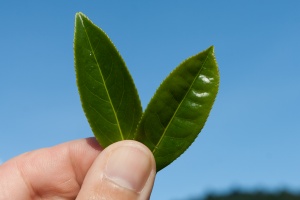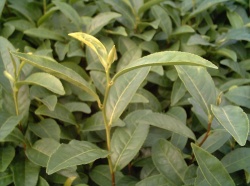Cultivar
Cultivar or varietal should not be confused with type of tea. The latter differ mainly by the processing while varietals are genetically different tea plants (within the Camellia sinensis family). A type of tea can be made from different varietals and still have the same name. But producer of exclusive teas tend to declarethe used variety or the variety is part of the name given.
Green tea
China
In China, the birthplace of tea culture, there are countless varieties. Often, variety and kind of tea are the same. This is particularly the case with oolong. On the other hand for the same tea can different varietals be used.
- Anji Baicha, although from the name and appearance it suggests to be a white tea but it's in fact a green varietal.
- Biyun
- Jiukengzhong
- Long Jing #43
- Yingshuang
Japan
Japan has a highly specialized tea industry. As a consequence many new varieties for different purposes are available.
- Asagiri
- Asahi
- Asatsuyu
- Fujikaori, cross between Yabukita and Inzatsu 131
- Fukumidori, cross between Yabukita and Sayamamidori.
- Fushun
- Gokou
- Horyoku
- Inzatsu 131
- Izumi
- Kanayamidori
- Karabeni
- Komakage
- Kuritawase
- Kurusawa, cross between Yabukita and a unknown cultivar.
- Makinoharawase
- Meiryoku, cross between Yabukita and Z1.
- Natsumidori
- Oiwase, cross between Yabukita and Yaeho.
- Okuhikari
- Okumidori
- Okumusahi, cross between Sayamamidori und Yamatomidori.
- Okuyutaka
- Ryohofu, cross between Yabukita and Hoyofu.
- Saemidori, cross between Yabukita and Asatsuyu.
- Samidori
- Sayama
- Sayamakaori, cross between Yabukita and a unknown cultivar.
- Sayamamidori
- Shizu 7132
- Shunmei, cross between Yutakamidori and a unknown cultivar.
- Surugawase, cross between Yabukita and a unknown cultivar.
- Tadanishiki
- Takachiho
- Tamamidori
- Tsuyuhikari
- Toyoka, cross between Asatsuyu and Sayamamidori.
- Uji Midori
- Uji Hikari, used for Matcha.
- Yabukita
- Yaeho
- Yamakai, cross between Yabukita and a unknown cultivar.
- Yamanami
- Yamano Ibuki
- Yamatomidori
- Yutakamidori, cross between Asatsuyu and a unknown cultivar.
- Yuukimidori
- Zairai, is not a varietal name but indicates the tea garden where the tea was grown.
Oolong
China
- Huang Jin Gui
- Fo Shou (Buddhas Hand)
- Qi Lan
- Tie Guanyin
- Jin Guanyin
- Huang Guanyin
Japan
- Minami Sayaka
- Sakimidori
- Takachiho
Taiwan
- TTES #12 Jin Xuan
- TTES #13 Cuy Yu
- TTES #17 Ruan Zhi
- TTES #18 Hong Yu
- Si Ji Chun
- Qing Xin (green heart), some claim it's a Ruan Zhi, some that it's a different varietal. Other names are Zhong Zhai and Zhong Cha.
- Da Ye (big leave)
- Ying Zhi Hong Xin (hard stem red heart)
- Qingxin Damo
- Huang Gan
New varietals:
- TTES #19
- TTES #20
Black tea
India
- Bannockburn 157
- Phoobsering 312
- Ambari Vegetative 2
Taiwan
- TTES #1-11
- TTES #8
- TTES #18 Ruby
- TTES #21 Hon Yu, cross between Keemun und Kyang.
Japan
As in Japan historically only green tea has been produced all cultivars are Sinensis var. sinensis. In order to produce black tea native teas were therefore crossed with Assam or with Chinese black tea varietals.
- Benifuji
- Benifuki, cross between Yutakamidori und Assam.
- Benihikari
- Benihomare
- Benikaori
- Hatsumomiji
White tea
China
- Fuding Da Bai
- Zhenghe Da Bai
- Ming Shan Bai Hao

